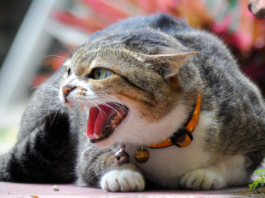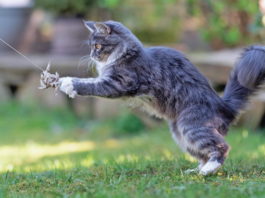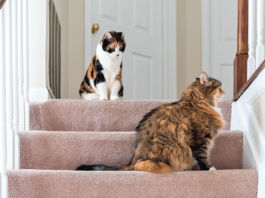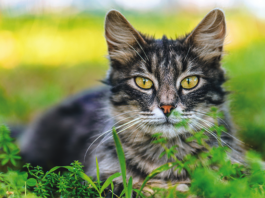Acupuncture for Cats Heads Mainstream
Dusty was a black and white cat who hissed, swatted and squirmed anytime a veterinarian or technician tried to restrain her for an examination or, worse, tried to draw blood or give an injection. This same cat, however, transformed into a picture of serenity and calm during acupuncture treatments.
In Cats, Fear and Shyness Can Look the Same
Not sure if a cat you want to adopt or even approach is fearful or simply shy? Recognizing the difference between the two behaviors can mean the start of a trusting relationship or the onslaught of an attack.A shy cat is more apt to freeze in place and tremble in hopes that you will walk away. A fearful cat will likely flatten his ears, dilate his pupils and deliver a warning hiss before swatting or biting you if you try to touch him.
International Experts Identify Signs of Pain
These are among key 25 signs of pain in cats identified in research at the University of Lincoln in the U.K. Dr. Isabella Merola and Daniel Mills, Professor of Veterinary Behavioral Medicine, surveyed international academics and practitioners with specialties in internal medicine, anesthesiology, oncology, dentistry, behavior, dermatology, ophthalmology and neurology. They say in PLOS One that the resulting list could lead to faster diagnoses and ultimately reduce suffering.
Download the Full May 2016 Issue PDF
Advances in treatments are helping people born with congenital heart disease live longer and with greater quality of life. But not all structural problems with the heart can be permanently fixed in childhood. In fact, many treatments that help get these patients into adulthood often need revisiting later in life. Being born with congenital heart disease means being always mindful of your heart health. Some of these individuals, because they have been heart patients their whole lives, are mindful of their diet, exercise and risk factor control.
Night Stalkers and Bedtime Howlers
At the end of a long workday, you look forward to uninterrupted slumber, but your cat has other plans. In two hours, he jars you awake by leaping on the bed - knocking the air out of you. An hour later, he swats a book off your nightstand. And 30 minutes before your alarm sounds, he begins loud, demanding meows.
Cats’ Behavior Affected Crucially Early in Life
Most of us recognize obvious signs of stress and anxiety in our cats - taking up residence under the bed being high on the list - but we may not be aware of more subtle signs, such as lowering the head and eyes, lifting a paw and staring at middle distance. These are among nearly 40 behaviors that may require intervention, according to the American Animal Hospital Associations 2015 Canine and Feline Behavior Management Guidelines, published this past summer. Behavioral problems affect more dogs and cats than any other medical condition and are one of the most common causes of euthanasia, relinquishment or abandonment of pets, the association says, adding that their management is essential in veterinary practice. It urges a culture of kindness that avoids the use of forced restraint.
Is Your Cat Squinting and Head Shy?
If your cat squints or his eyes are increasingly tearing, take a closer look. Does he have a red eye with a cloudy blue tint to the surface and a dilated pupil? These could be signs of glaucoma that require immediate treatment to avoid significant or complete loss of vision. Because of the subtle nature of the symptoms, some cats dont have a veterinary examination until substantial damage has occurred.
When Rough Play Gets Out of Hand
Your indoor cat needs and deserves daily play sessions to keep him physically and mentally fit. Play can help prevent him from engaging in destructive behaviors like shredding the sofa out of boredom or becoming obese from overeating to pass the time.
Why Cats Hate Veterinary Visits
More than half of cat owners - 58 percent - report that their cat hates going to the veterinarian, according to a study by Bayer Veterinary Care. They hide, hiss and howl for one simple reason: Theyre afraid. Through no fault of their own, cats native instinct to stay safe by avoiding the unfamiliar doesnt serve them in the crate, the car and the clinic.Cats may be unfamiliar with loud noises, such as barking dogs or vocalizing cats, strange odors in the air and on the floor of the clinic, and that translates into fear, says Leni K. Kaplan, MS, DVM, a lecturer in the Community Practice Service at Cornell University College of Veterinary Medicine. Cats are also routine-oriented, and going to the vet, which most likely involves traveling in a car, is not part of their regular routine.
Content, Agitated, Fearful, Aggressive?
Scientists estimate that cats have lived with us for at least 9,000 years, and surveys show that many of the 45 million households in the U.S. today consider their 96 million cats bona fide members of the family. Yet after all these years, how well do we really understand cats?It turns out not that well, says Katherine Houpt, VMD, Ph.D., animal behaviorist and professor emeritus at Cornell University College of Veterinary Medicine. Cats body language is daunting for many of us to interpret, particularly because of their anatomy.
Neither a Smile, Nor a Grimace
If your cat curls his top lip and inhales, he may look as if hes smiling or even grimacing, but hes actually sniffing out odors. The behavior, called the flehmen response, is particular to mammals, such as members of the cat family, horses, cattle and pigs.
Ask Elizabeth: March 2015
Q. Ive been feeding a neutered male outdoor cat for the past few weeks, and he is aggressively friendly. On two occasions, he attacked my legs with his claws when I was walking to his food bowl to fill it. I began taking a spray bottle with me and squirted him when he got too close but stopped that because I thought it would only confuse him. Lately, he has not attacked me but is still very persistent in rubbing against me to the point of almost causing me to trip. Is there anything I can do to calm him down before mealtime?

















